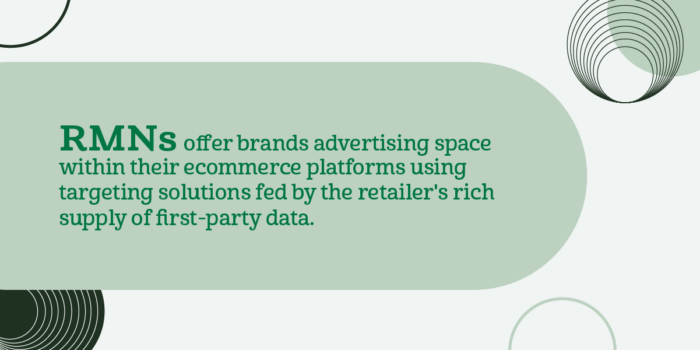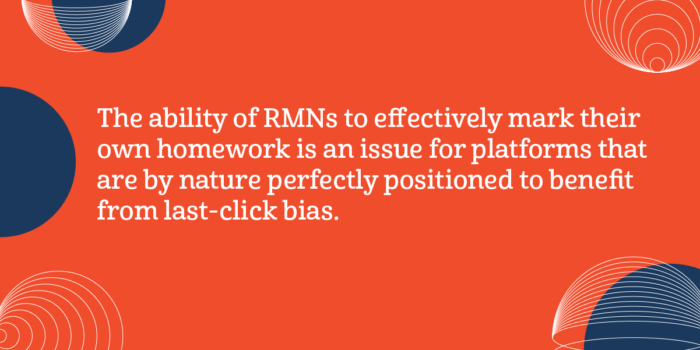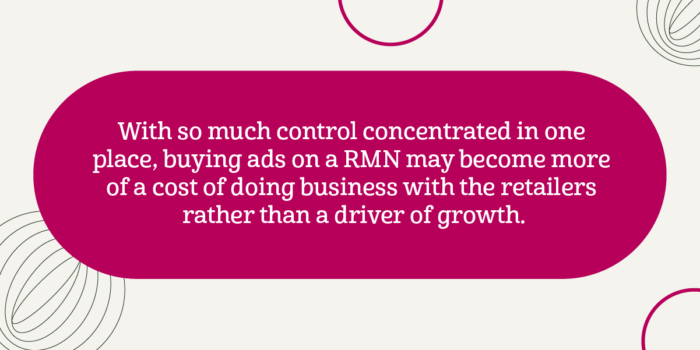It seems that no matter what condition the digital advertising ecosystem is in, new big fishes will always enter the pond. The latest are retail media networks (RMNs). Born from the likes of Amazon, Walmart, and Tesco, retail media networks have grown massively thanks to the sudden increase in demand for access to a brand’s first-party data.
What Are Retail Media Networks?

RMNs offer brands advertising space within the ecommerce platforms of retailers, with targeting solutions fed by the rich supply of first-party data generated by the retailers’ customers through online purchases and in-store loyalty schemes.
The inventory available depends on the retail media network, but typically they offer a mix of display and sponsored search ads across their websites, apps, and — if the retailer has a brick-and-mortar presence as well — in-store digital displays. It’s the digital equivalent of ads in a mall, offering a chance to make an impression on consumers when their purchasing intent is at its peak.
RMNs aren’t necessarily confined to serving audiences on their own sites. Using data platforms that can serve as connective tissue between distinct sites and channels — such as Lotame’s Spherical — retail media networks can expand their audiences and offer advertising solutions to partner properties across the wider digital sphere.
This effectively turns retail media networks into a more typical ad network, or — if they have their own DSP, as Walmart Connect does — a trading desk. There are already signs of RMNs overlapping into other channels such as CTV, as seen in the Channel 4 and Nectar360 partnership in the UK, which allows the Nectar’s advertisers to target its audiences via Channel 4’s BVOD service. Similarly, in the US Disney+ and Kroger announced a beta test for CPG marketers to target audiences using shopper data
While the likes of Walmart and Kroger might get all the attention, there is potential for smaller retailers to establish a footing, especially if they learn from publisher advertising networks such as The Ozone Project. These networks aggregate audience data and inventory availability across domains of publishers large and small so that they can, collectively, offer comparable scale to their larger counterparts.
A similar approach may be viable in the retail media network space, and would help overcome the limitations of advertising to non-endemic brands, which we will cover below.
Sounds Great! What’s the Risk?
The arrival of RMNs has coincided with marketers entering a phase of cautious budget pruning as economic storm clouds dampen confidence that budget expansion will pay off.
Marketers do, however, still have an appetite for experimentation and are willing to explore new opportunities in the increasingly competitive race for the attention of consumers, who are also tightening their budgets.

This tug-of-war between pruning and experimentation means that the spend marketers feed to RMNs is being taken from other media channels. Budget rebalancing carries risk, but this can be minimized with a strategic approach that weighs the suitability of each channel in the media mix against the brand, product, audience, and broader business objectives.
Should Marketers Invest in Retail Media Networks?
RMNs have many characteristics of a safe investment:
- They’re growing: with forecasted investment of $122 billion this year and a growth trajectory that will overtake linear TV by 2025. Retail media networks have attracted everyone from big brands to local advertisers and have spurred integrations with publishers, social platforms, and CTV.
- They promise precision: in a time of third-party cookie deprecation, Apple’s policy changes, and privacy regulations, signal fidelity has been cut by 50–60%. Retail media networks’ offer a treasure trove of a brand’s first-party data to run highly targeted campaigns.
- They offer scale: in the US alone, Amazon’s website attracts 2.55 billion visits, Walmart brings in 410 million, and Kroger’s acquisition of Albertson’s will expand its reach to 85 million households.
However, RMNs settle firmly towards the bottom of the sales funnel, with strong potential to impact conversions, slight impact in the consideration phase, and minimal impact on awareness.
Marketers tasked with building brand equity must therefore ensure any spend redirected to retail media networks is not taken from upper funnel channels. Otherwise, they may be trading a short-term sales boost for a drop in market share further down the line.
After all, seeing an ad for a product on a retail site might nudge a consumer towards a purchase, but the odds of this happening are significantly lower if they have no awareness of the product to begin with.
Marketers also need to watch out for becoming locked in golden handcuffs of data dependency. RMNs are the very definition of walled gardens, with all the same issues of their media rivals Google, Meta, and Apple. Each operates a black box model where the buyer simply has to trust that the campaigns are running as effectively as possible.

Without transparency, marketers cannot audit the decisions made by the platform’s algorithms, while access to data and integration of third-party tools is strictly controlled. This ability of RMNs to effectively mark their own homework is an issue for platforms that are by nature perfectly positioned to benefit from last-click bias.
Let’s say that a customer visits a retailer to purchase a specific product and — having been correctly identified as a high-intent prospect — is shown an ad for that same product. The customer, who has already made up their mind about what they’re buying, would then effectively use the ad as a shortcut to the product page. Despite the ad having minimal effect on their decision to purchase, the sale would still be attributed to it.
Spend on retail media networks — as with any walled garden — should be balanced with investment in owned customer insights and marketing campaigns through media channels or partnerships where there is greater transparency and a more equal value exchange. The open web has a diverse array of first-, second-, and third-party data sources that can be pulled together to build a map of customer behaviors and audience movements that marketers can explore on their own terms.
Are RMNs Worth It For Non-Endemic Brands?
Of course, some brands are better positioned for data independence than others.
CPG brands outside of the D2C niche are typically short on first-party data and have always relied on external partners and retailers for customer and market insight. Most also sell their products — some exclusively — via the same retailers offering retail media networks, making them a one-stop-shop for advertising, sales, and distribution.
With so much control concentrated in one place, buying ads on a retail media network may become more of a cost of doing business with the retailers rather than a driver of growth. It’s no wonder 85% of brands feel they are pressured by retailers to support RMNs, reflecting a similar sentiment of reluctant reliance on walled gardens that we found amongst marketers in our Beyond the Cookie 3 survey.

As for non-endemic brands (those that don’t sell products through the retailers behind RMNs, for example, a financial services company selling on a clothing site), whether these platforms offer any value remains to be seen.
The average consumer may spend hours a month shopping online — GenXers and Millennials even more so — but are they in the mindset to be interested in holidays or financial services? And would it even be worth competing for ad space against endemic brands that see RMNs as a key sales driver?
It’s worth noting here that the first high-profile retail media network failure, GPS Media from GAP, was wholly reliant on non-endemic advertisers.
How much incremental growth still-nascent RMNs can drive over other channels and — as there are no unified measurement standards between them — each other remains to be seen.
Given the transparency issues noted above, assessing the true value of RMNs will remain a challenge, and we will only get a clear view after they have settled into the market and there has been time for detailed analysis that can separate their uplift from all other channels.
What we can predict with certainty is that RMNs are here to stay and have strong potential as a key sales driver for products sold through their retail arms. It is a channel worth exploring while bearing in mind the caveats outlined above.
As always, marketers should keep their media mix diverse, avoid putting all eggs in one basket, and build out their data connectivity to gain a holistic — and independent — view of prospects and customers alike.
Want to discuss your options further? We’d love to help weigh the pros and cons of investing in your own retail media network, as well as help you get the most out of your own data. Learn how Spherical, Lotame’s end-to-end data collaboration platform, can offer smarter, faster and easier ways to drive growth and derive value from your data – whether you have it or need it.


